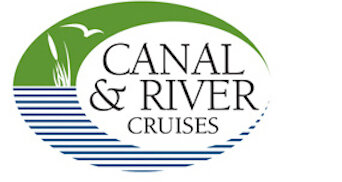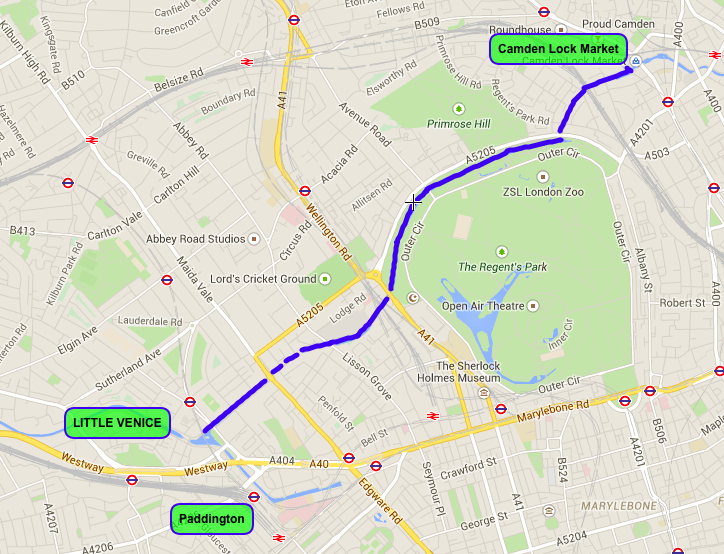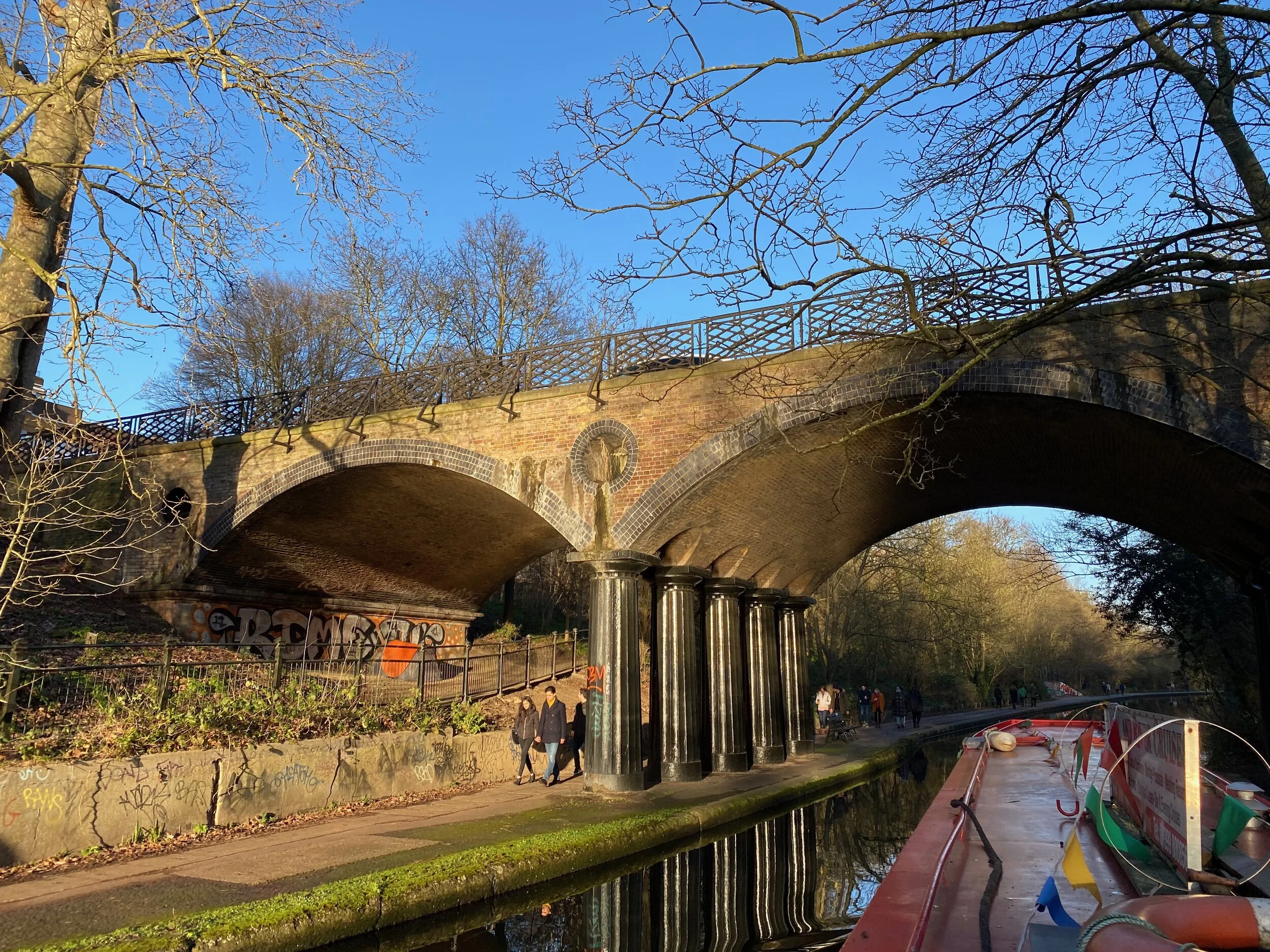A trip from Little Venice to Camden along the Regent's Canal and back.
Little Venice to Camden
The Puppet Theatre Barge in Little Venice
Regent's Park
Blow Up Bridge, Regent's Park
Approaching Camden Lock
2 Hours return trip, 2.5 miles each way, 0 locks
Little Venice to Camden is our most popular cruise – it takes two hours return and is the perfect route for our two hour Party Picnic Cruises. Theres nowhere else like it on the UK Canal system – urban canals are often industrial but we have wildlife, a royal park, a zoo, two tunnels, historic boats, villas and mansions. How amazing is that!
We will start the trip from our own home moorings in London’s Little Venice, the very attractive and peaceful waterside areas along the Grand Union Canal and Regents Canal in Maida Vale. The elegant houses which line the canal were built in the 1840’s so for the first forty years or so, Little Venice was actually in the countryside and was the natural place to locate the new wharves alongside the outer limits of Central London, where canal boats would be delivering their cargo for onward shipment by horse and cart around the city. Robert Browning lived beside the canal in the 1860’s before moving to Italy and its said he died in Venice, which is a possible reason for the naming of Little Venice, but this wasn’t widely used until the 1950’s. Whether this is true we don’t know but certainly the island bird sanctuary in the heart of Little Venice is now called Browning’s Island and there’s a memorial to Browning near where he used to live in the canal-side Warwick Crescent. Some would rather say that Lord Byron first mentioned Venice when comparing our canals to those he had seen in Venice, and he wasn’t very impressed!
We usually take a quick spin around the Browning’s Island to look at the birds – resident swans, geese, ducks, coots, moorhens are now joined by cormorants, the occasional heron and some very pretty ornamental ducks which visit the canal from the ponds in Regents Park. Its not unusual to see Mandarin Ducks, Pochards and Tufted Ducks or Egyptian Geese.
Originally there was no way through to the Thames from the Grand Union Canal so in 1812 it was decided to build a new canal to connect the canals to the river and the world of international trade which this would open up. The new canal was named The Regent’s Canal by John Nash, the famous London architect responsible for so much development during the 1800s, gaining approval from his employer The Prince Regent while designing Regent’s Park, and was opened to Camden in 1816 and all the way to Limehouse in 1820.
Leaving Little Venice to the east we pass under Warwick Avenue, joining the Regents Canal and follow Blomfield Road and Maida Avenue where the canal is lined on both sides with permanently moored narrowboats and forms the boundary between Maida Vale W9 and Paddington, W2. In the distance we see the Maida Hill tunnel where we will shortly be passing through 272 yards underground, below Edgware Road and you’ll discover how the old horse drawn boats were propelled through the tunnel where no towpath exists for the horses.
Lisson Grove has London’s shortest tunnel of 47 yards, leading into the widened canal where the old coal boats delivered for the power station which originally sat beside the canal, now replaced with the modern St Johns Wood substation and the old coal wharves now form more permanent moorings.
We are in the Marylebone area, passing under Park Road into the northern edge of Regents Park. If you look carefully through the trees to our right you’ll catch a glimpse of Hanover Lodge, one of London’s most expensive private houses but you’ll be more impressed with the six more modern but classically designed villas which line the canal atop the embankment built by John Nash who tried to hide the canal from the super rich clients who were the first residents of Regent’s Park at exactly the same time as the canal was being constructed between 1812 and 1821.
The canal now runs along the northern boundary of Regent’s Park after John Nash hurriedly changed his original plans to use it as the centre feature. He changed his mind when he allegedly realised that the canal was industrial and dirty after paying a visit to the basin at Paddington. Outside the park is St Johns Wood.
Don’t miss Blow Up Bridge, one of the most famous canal locations in London, where in 1874 a boat called The Tilbury apparently exploded due to the unfortunate combination of gunpowder and petroleum spirit which was in the hold. The new railways had already realised that this was too dangerous to carry behind a steam train, but it took this enormous explosion on the canal to tighten up the rules for boats. The bridge and boat were destroyed along with local houses, yet the bridge was rebuilt to the same design using the original cast iron columns which bear the name CoalbrookDale, the most famous iron works in the world. Did those splendid columns come to London by road? No – they must surely have come by canal as this is a great example of the sort of goods which were too heavy to move long distances until enabled by our canals!
We pass through 400 yards of London Zoo before turning away from Regents Park at Cumberland Basin, named after the Cumberland Market which was served by a half mile extension of the canal here until its closure in 1921. The disused canal branch was then closed and finally filled in with rubble from the Blitz during World War Two.
Skirting round Primrose Hill we then enter the Camden area and finally see some signs of industry in the form of the old warehouses originally owned by Gilbeys, at the time being the worlds biggest wine and spirit merchant based here in Camden during the 1900s and makers of Gilbeys London Gin, exported from Camden to all over the world. Did you find the statue of a cow more interesting? Thought so :).
Camden is of course most famous today for Camden Lock Market, although there’s officially no such place on the canal map as Camden Lock. The name was coined in 1983 by TV-AM breakfast TV station and Camden Lock Market, which has evolved to become one of London’s most visited tourist attractions. What better way to arrive than by boat, where we can drop you off right outside the entrance gateway to the West Yard of the market. Just a few steps away you can view the Hampstead Road Locks, the first of twelve locks which gently lower the canal down the 86 feet to the river Thames at Limehouse, still 6 miles from here. On a round trip of course, we won’t be stopping here, and will turn around in the wide basin ready for the trip back to Little Venice.





